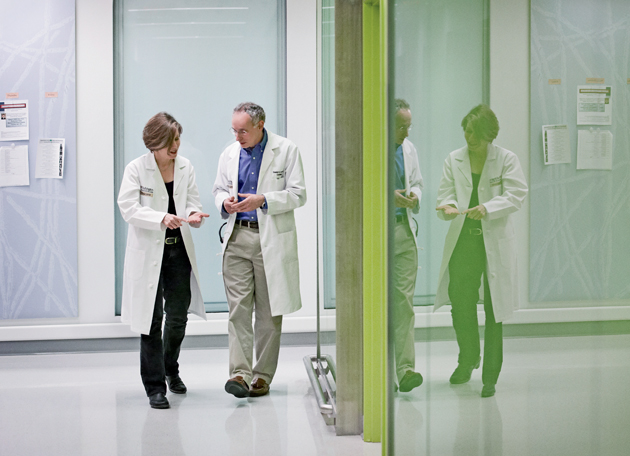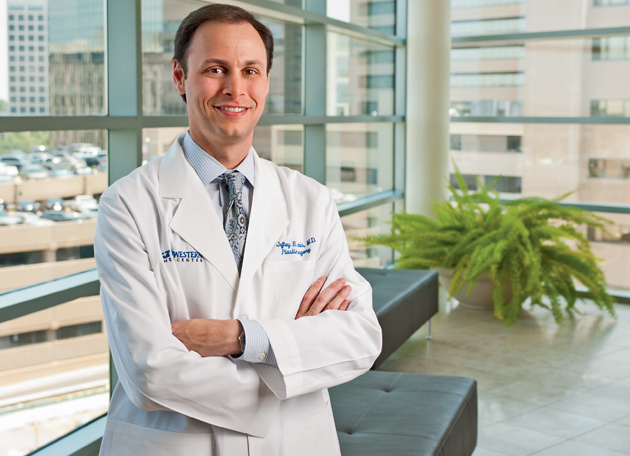
A multidisciplinary approach is key to decoding complex health issues and to developing new, more effective therapies and diagnostic tools. This means tearing down artificial barriers to encourage collaboration among the university’s schools, departments and centers, and synergizing research efforts toward common goals.
One instance of such a successful multidisciplinary collaboration is Jean Schaffer, MD, and Daniel Ory, MD, at the Diabetic Cardiovascular Disease Center.
Combining forces with researchers at other institutions with intersecting areas of expertise can lead to technological breakthroughs and amazing successes in patient care as well.
Alumnus Jeffrey Janis, MD, illustrates this principle through his work leading up to a full-face transplant, the first in the United States.
Finding the connection between diabetes and cardiovascular disease
Diabetes, a particularly complex disease that is best studied through a multidisciplinary approach because it impacts so many functions of the body, affects almost 26 million people in the United States (with another 79 million having undiagnosed diabetes or pre-diabetes). Nearly two-thirds of those with diabetes will die from heart disease or stroke.
The link between diabetes and cardiovascular disease is the focus of the Diabetic Cardiovascular Disease Center (DCDC), which was established through BioMed 21 (see sidebar). The center brings together a diverse team of scientists with expertise in cardiology, endocrinology, chemistry, cell biology and physiology, radiology, pharmacology, physics, nutritional biology and more. Together, they are working to increase knowledge of the disease and to develop better tools for diagnosing and treating patients.
“We are truly fortunate at Washington University to have an incredibly rich community of physician-scientists with high motivation not only to discern the biological underpinnings of disease, but also to translate findings into improvements for our patients. The Diabetic Cardiovascular Disease Center is enabling us to develop resources to translate discoveries at a faster pace.”
—Jean Schaffer, MD
Led by wife-and-husband team Jean Schaffer, MD, and Dan Ory, MD, the center represents a new paradigm for translating basic laboratory discoveries into tangible advancements in patient care — often one of the biggest hurdles in medical science. Thus the DCDC’s approach to studying diabetic lipid disorders, for example, is two-pronged: First, they seek to better understand the mechanisms behind the toxic effect of lipids (or fats) on the cardiovascular system. Second, they aim to create new diagnostic tools to better detect these specific toxic effects and facilitate early treatment.
Schaffer, the Virginia Minnich Distinguished Professor of Medicine, co-directs the DCDC as well as directs the Diabetes Research Center. Where DCDC is sharply focused on the cardiovascular implications of the disease, the Diabetes Research Center encompasses all areas of diabetes research. Schaffer specifically focuses on the combined stress of high fat and sugar, particularly in the cardiovascular system.
Daniel Ory, professor of medicine and co-director of DCDC, studies the origins of atherosclerosis and uses that knowledge to identify biomarkers that can help physicians better monitor the disease in their patients. The biomarker research has been strengthened through the creation of the Metabolomics Facility in partnership with the Center for Women’s Infectious Disease Research at the School of Medicine. This facility uses mass spectrometry (to determine the mass of particles and, by extension, their chemical structure) for the analysis of small molecule metabolites in blood or body fluids. This technique allows researchers to identify biomarkers for the detection and treatment of human diseases. The Metabolomics Facility builds on the outstanding expertise in mass spectrometry at the university, providing for the first time a resource with the capacity to analyze samples from large clinical studies.
“The facility has a number of sensitive instruments that can accurately measure a broad range of metabolites in very small amounts in biological specimens such as blood and urine,” Ory says. “It’s one thing to develop this in the laboratory. But it’s quite another to translate a laboratory assay into an FDA-compliant, clinical-grade assay that we implement at Barnes-Jewish Hospital or the Mayo Clinic to measure these substances in patients. That’s the area we’ve been focusing on.” Moreover, the medical school’s investment in DCDC and its Metabolomics Facility was instrumental in enabling a team of WUSTL scientists, led by Schaffer, to successfully compete this year for a $4.7 million award from the National Heart, Lung and Blood Institute to extend their initial studies of heart function and diabetes to the Framingham Heart Study.
“We are truly fortunate at Washington University to have an incredibly rich community of physician-scientists with high motivation not only to discern the biological underpinnings of disease, but also to translate findings into improvements for our patients,” Schaffer says. “The Diabetic Cardiovascular Disease Center is enabling us to develop resources to translate discoveries at a faster pace.”
“What Jean and Dan do is fantastic,” says Douglas L. Mann, MD, the Tobias and Hortense Lewin Professor of Medicine and chief, Cardiovascular Division, as well as acting director of the Center for Cardiovascular Research. “Those two collaborate seamlessly. They’re both working to identify novel biomarkers that may predict disease and then help to follow disease. Jean was instrumental in defining the role of what’s called lipotoxicity, when the cell can’t metabolize its own lipids and they build up and cause cardiac toxicity. That’s proven to be a huge problem in heart failure and cardiovascular disease.”
Daniel Ory, MD, points out that the development of interdisciplinary centers like DCDC represents the intersection of interests from different departments, channeled toward common goals.
According to Mann, the work in DCDC should pave the way for understanding diabetic heart disease in a more fundamental way. The biomarker discovery research especially is exciting because it’s novel and offers the hope for being able to identify these patients at the earliest points and intervene before they become sick.
Ory points out that the development of interdisciplinary centers like DCDC represents the intersection of interests from different departments, channeled toward common goals.
“We have a large group of people who are focused on heart failure, and it spans from the bench to the bedside,” Mann says. “Investigators in the Cardiovascular Division, for example, are trying to figure out what is the safest, fastest, best, least expensive way to perform cardiac intervention. And we’ve got a large initiative trying to understand what the basic molecular factors are that actually allow the heart to heal.”
As obesity and diabetes become increasingly common around the world, the need for better diagnostic and treatment options grows more urgent.
“Diabetes creates an abnormal metabolic milieu that affects virtually every organ in the body,” Schaffer says. “Not only do people with diabetes have a greater likelihood of developing heart disease, but the diabetic environment also predisposes them to more aggressive disease. Further, people with diabetes clearly have dysfunction of their heart muscle as well as the disease affecting the blood vessels.”
DCDC’s long-term objectives are to develop new tests to identify which diabetics going into a physician’s office need special consideration because their test results indicate a higher risk for heart failure or atherosclerosis.
Restoring someone’s life
“I have a passion for what I’m doing,” says Jeffrey Janis, MD, associate professor of plastic surgery and program director at the University of Texas Southwestern Medical Center in Dallas.
A business major at Washington U., Janis, BSBA ’93, credits biology professor Johns Hopkins with changing his trajectory during his junior year: “Dr. Hopkins actually changed my life. He doesn’t know it. But by taking the time and interest, pulling me aside, and giving me some inspiration to go a different direction, he set me on the path to becoming a doctor.”
Janis’ research interests include wound healing, abdominal wall reconstruction, the surgical treatment of migraine headaches, and improving outcomes in training the next generation of plastic surgeons.
Migraine headaches can be debilitating, causing intense pain as well as other symptoms such as nausea and sensitivity to light and noise. The patients whom neurologists refer to Janis suffer from recurring migraines that have not responded well to other treatments.
Janis began collaborating several years ago with Bahman Guyuron, MD, a plastic surgeon at Case Western University, who discovered that several patients’ migraines disappeared after they had cosmetic brow lifts. Using Botox as a diagnostic tool, the two have identified several potential trigger points for migraines.
“Some misconceptions abound regarding the field of plastic surgery. Many people equate it solely with aesthetic surgery. But, actually, it is both cosmetic and reconstructive, in that we’re fully trained to handle all kinds of patients.”
—Jeffrey Janis, MD
With each patient, Janis injects each identified area one at a time in a process of elimination, immobilizing the muscle to relieve pressure on nearby nerves and effectively deactivate the trigger point. He can then focus surgical intervention on the trigger point to alleviate the migraine pain.
“Some misconceptions abound regarding the field of plastic surgery,” Janis says. “Many people equate it solely with aesthetic surgery. But, actually, it is both cosmetic and reconstructive, in that we’re fully trained to handle all kinds of patients.”
Janis is also chief of plastic surgery for Parkland Health and Hospital System, a Level 1 trauma center, where President Kennedy was brought after being shot. The majority of his work is reconstructive.
“Parkland is known for taking on very complicated patients,” he says, “people who are disfigured from trauma or cancer. These patients want to be made to feel whole again as a person, and my job is to find a way to do that physically, emotionally and mentally. It’s not just rearranging tissue, it’s restoring somebody’s life.”
His most moving experience has been the four-year, ongoing journey with a young man named Dallas Wiens, who arrived at the Parkland burn unit in 2008 after his face came into contact with a high-voltage power line while he was on a hydraulic lift. The resulting deep tissue burns were so extensive that the bones of his skull were scorched.
“Most people do not survive an injury like that, as you might imagine,” Janis says. “If they make it to the hospital alive, they don’t leave because they succumb to their injuries. But he made it to the hospital, and he was able to leave. It took a few months, but the burn unit saved his life.”
“After 22 surgeries, he was able to leave the hospital and be with his daughter. I followed him as an outpatient in the clinic. He was a very uplifting and inspirational patient to care for because, despite having such devastating injuries, he still wore a smile and kept a positive attitude.”
—Jeffrey Janis, MD
Janis was consulted as chief of plastic surgery to determine if Wiens was a candidate for reconstruction. The devastating injury involved every feature of his face. After the removal of all the dead tissue, Janis says, Wiens’ face “essentially looked like a skull on top of a body.”
After scouring medical literature for guidance, Janis realized this type of injury was so rare that he would have to design a completely customized treatment plan. He moved muscles from Wiens’ back and sides to create a scaffold on which to graft skin from Wiens’ thigh and reconstruct a face. But it didn’t really look like a face. Wiens was blind, and his face was fairly featureless due to the extent and severity of the injury.
“After 22 surgeries, he was able to leave the hospital and be with his daughter,” Janis says. “I followed him as an outpatient in the clinic. He was a very uplifting and inspirational patient to care for because, despite having such devastating injuries, he still wore a smile and kept a positive attitude.”
Then, while presenting Wiens’ case at the 2009 annual meeting of the American Society of Plastic Surgeons, Janis met Bohdan Pomahac. Pomahac, MD, assistant professor at Harvard Medical School and director of the Burn Center and of Plastic Surgery Transplantation at Brigham and Woman’s Hospital, was also presenting, but on the results of a partial face transplant.
“I introduced myself, and said, ‘I think what you are doing is phenomenal, and I may have a patient for you,’” Wiens says. “Dr. Pomahac, who had seen my presentation, said, ‘I think I can help.’”
Excited, Janis pitched the idea of a face transplant to Wiens, who responded enthusiastically. At that time, only two partial face transplants had been performed in the United States, one at the Cleveland Clinic and one by Pomahac in Boston. Janis accompanied Wiens to Boston for evaluation. And, in March 2011, Janis joined the team in Boston for the 14-hour surgery to give Wiens the first full-face transplant in the United States and the third in the world. Although still blind, Wiens now has a sense of smell and sensation in his face.
“The future of this specialty is dependent upon pioneers who are willing to take calculated risks and put the patient at the center of the system,” Janis says. “Everybody pulled together in a multidisciplinary team effort in order to rally around this individual. Ultimately, he got his face back, and he got his life back. All he ever wanted was to feel his daughter’s kisses on his face again, and now he can feel those kisses.”
Terri McClain is a freelance writer based in St. Charles, Mo.


Comments and respectful dialogue are encouraged, but content will be moderated. Please, no personal attacks, obscenity or profanity, selling of commercial products, or endorsements of political candidates or positions. We reserve the right to remove any inappropriate comments. We also cannot address individual medical concerns or provide medical advice in this forum.